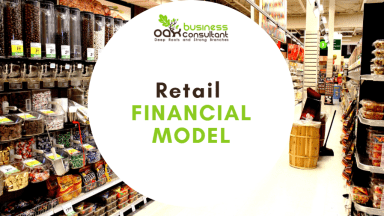
Originally published: 03/04/2020 10:41
Publication number: ELQ-86077-1
View all versions & Certificate
Publication number: ELQ-86077-1
View all versions & Certificate

Retail - Financial Model
The Retail - Financial Model is specially developed for a Retail Startup business.
Our mission is to be the industrial leader and pioneer in our business domainFollow 12
Description
This financial model is a template for businesses related to the retail industry. The figures in the template have multiple categories with multiple types of products in each category. Users can re-name those to whatever categories that fit their retail business. The model is dynamic multi-purpose and is capable of adopting any retail business that sells various product lines.
The assumption logic below explains how revenues and expenses are populated per various inputs.
Each sub-category allows users to have a low/mid/high pricing tier and you can determine the % of sales coming from each pricing level. The reason that was done is so that the user can generalize the sub-categories to get a better feel for the true average revenues coming in.
The Dashboard which is a graphical representation of revenue, sales and breakeven are dynamic. Which means any change in value will have an impact on it. For clients, I have included Investment data, Expenses, Revenue model, Cost model and OpEx in sheet 2 where you can just change values and assumptions which automatically will have an impact on other sheets.
Based on all these various assumptions, the user will automatically see the monthly P&L populate and this shows all revenues from each sub-category, the sales count for each, the cost for each, and on based on low, mid, high-level pricing tiers.
Summary tabs include:
1. Discounted Cash Flow Valuation: Includes various exit valuation methods.
2. Break-Even: Shows the amount of annual revenue needed to break even each year based on the total variable costs and fixed costs (also shows the number of months needed to break even (leveraged / non-leveraged
3. Income Statement: Yearly and month-wise income statement, cells are created in such a way that any change will have an impact on others.
4. Balance sheet
5. Project Evaluation: Net Present Value (NPV) is the value of all future Cash Flows (positive and negative) over the entire life of an investment discounted to the present. This model includes Investment required, Equity raised, Future values, Net Income, Total Investment, WACC, EBITDA and Growth rate
6. Metrics: Earnings Before Interest, Taxes, Depreciation, and Amortization and is a metric used to evaluate a company’s operating performance linked with the income statement and other sheets
7. Depreciation and Amortization: Three-year projection of depreciation and amortization.
8. Sales Forecast
Use of model:
The model is most suited to almost all kinds of retail businesses like:
• Grocery Store
• Merchandise Stores
• Non-Store Retailers
• Special Service Shops
This financial model is a template for businesses related to the retail industry. The figures in the template have multiple categories with multiple types of products in each category. Users can re-name those to whatever categories that fit their retail business. The model is dynamic multi-purpose and is capable of adopting any retail business that sells various product lines.
The assumption logic below explains how revenues and expenses are populated per various inputs.
Each sub-category allows users to have a low/mid/high pricing tier and you can determine the % of sales coming from each pricing level. The reason that was done is so that the user can generalize the sub-categories to get a better feel for the true average revenues coming in.
The Dashboard which is a graphical representation of revenue, sales and breakeven are dynamic. Which means any change in value will have an impact on it. For clients, I have included Investment data, Expenses, Revenue model, Cost model and OpEx in sheet 2 where you can just change values and assumptions which automatically will have an impact on other sheets.
Based on all these various assumptions, the user will automatically see the monthly P&L populate and this shows all revenues from each sub-category, the sales count for each, the cost for each, and on based on low, mid, high-level pricing tiers.
Summary tabs include:
1. Discounted Cash Flow Valuation: Includes various exit valuation methods.
2. Break-Even: Shows the amount of annual revenue needed to break even each year based on the total variable costs and fixed costs (also shows the number of months needed to break even (leveraged / non-leveraged
3. Income Statement: Yearly and month-wise income statement, cells are created in such a way that any change will have an impact on others.
4. Balance sheet
5. Project Evaluation: Net Present Value (NPV) is the value of all future Cash Flows (positive and negative) over the entire life of an investment discounted to the present. This model includes Investment required, Equity raised, Future values, Net Income, Total Investment, WACC, EBITDA and Growth rate
6. Metrics: Earnings Before Interest, Taxes, Depreciation, and Amortization and is a metric used to evaluate a company’s operating performance linked with the income statement and other sheets
7. Depreciation and Amortization: Three-year projection of depreciation and amortization.
8. Sales Forecast
Use of model:
The model is most suited to almost all kinds of retail businesses like:
• Grocery Store
• Merchandise Stores
• Non-Store Retailers
• Special Service Shops
This Best Practice includes
1 Excel File










